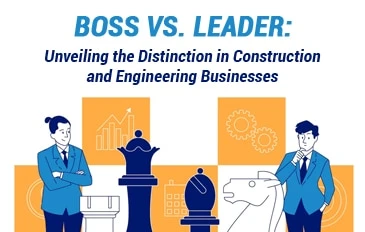Boss vs. Leader: Unveiling the Distinction in Construction and Engineering Businesses

Boss vs. Leader: Unveiling the Distinction in Construction and Engineering Businesses
In the construction and engineering industries, effective leadership is paramount to success. However, being a boss and being a leader are not interchangeable terms. This blog post aims to explore the fundamental differences between being a boss and being a leader within the context of construction and engineering businesses. We will delve into the qualities, approaches, and impacts of both roles to understand how they shape organizational culture, employee engagement, and overall project outcomes.
- Authority vs. Influence: A boss typically relies on their position of authority to exercise control and demand compliance. They use their formal power to make decisions, assign tasks, and enforce regulations. In contrast, a leader focuses on influence rather than authority. They earn the respect and trust of their team through their expertise, communication skills, and ability to inspire. Leaders lead by example and motivate their team members to achieve their best.
- Transactional vs. Transformational: A boss tends to employ a transactional leadership style, which centers around rewarding or punishing employees based on performance. They focus on meeting specific targets and enforcing rules to maintain discipline. On the other hand, a leader adopts a transformational leadership style, inspiring and empowering their team members to grow, innovate, and excel. They foster a collaborative environment that encourages personal and professional development.
- Task-Oriented vs. People-Oriented: Bosses are typically task-oriented, prioritizing productivity and efficiency. They may overlook the individual needs, motivations, and well-being of their team members. Leaders, on the other hand, are people-oriented. They invest time and effort in understanding their employees, providing guidance, mentorship, and support. Leaders value the unique strengths of their team members and align their roles with individual capabilities for optimal performance.
- Short-Term vs. Long-Term Focus: A boss often focuses on short-term goals and immediate results. Their decision-making revolves around meeting deadlines and achieving immediate objectives, sometimes overlooking the long-term consequences. In contrast, leaders take a more strategic approach, considering the long-term impact of their decisions. They envision the future, set clear goals, and inspire their team to work towards a shared vision of success.
- Control vs. Empowerment: Bosses typically maintain tight control over their team members, dictating the how, when, and what of tasks. They have a top-down approach, stifling creativity and autonomy. Conversely, leaders believe in empowering their team members. They delegate responsibilities, encourage innovation, and trust their employees to make informed decisions. Leaders create an environment that fosters ownership, collaboration, and continuous improvement.
- Impact on Organizational Culture: The leadership style employed within construction and engineering businesses significantly impacts the organizational culture. A boss-driven culture may breed fear, resentment, and disengagement among employees. It can result in high turnover rates and limited employee loyalty. In contrast, a leader-driven culture fosters trust, open communication, and a sense of belonging. It encourages employee growth, job satisfaction, and loyalty, ultimately leading to increased productivity and innovation.
In conclusion: the construction and engineering industries, being a boss is not synonymous with being a leader. While a boss relies on authority and transactional relationships, a leader inspires through influence and transformation. The distinction between the two lies in their approaches to authority, communication, employee empowerment, and long-term vision. By embracing leadership qualities and adopting a transformational style, construction and engineering professionals can create an environment that fosters growth, collaboration, and exceptional project outcomes.
Michael DeSafey is a leading executive recruiter for professionals in the construction, engineering, and environmental industries. He is currently the President of Webuild Staffing: www.webuildstaffing.com. To learn more about Michael, or to follow his blog, please visit www.michaeldesafey.com.
Category: Career Training, Construction, Employer Tips, Jobs, Recruiting
Twelve Tips for Effectively Running a Construction Management Business

Twelve Tips for Effectively Running a Construction Management Business
Running a construction business can be a stressful experience. There are ways to alleviate some of that stress, primarily by staying organized to give yourself the confidence that you are managing to the best of your ability. Start by following our 12 tips below!
- Establish Clear Project Specifications
Outline parameters including company, objectives, budgets, scope, time, reporting, materials, employees, and deadlines.
- Create a Strong and Engaged Team
Align workers’ skills with appropriate placement and make sure they understand their roles and responsibilities. Help workers see how their contribution affects the end goal. Your team’s dedication and efforts will make the difference between a project that is a failure or a success. Put milestones and deadlines on a calendar and schedule regular meetings. Deal with issues as they come; don’t brush them off for later. Celebrate achievements and reward team members.
- Break Down Complex Problems
Whatever the issue, make it more comfortable to deal with by breaking it down into measurable and manageable pieces that can be assigned to different team members.
- Invest in a Construction Project Management Software (CPM)
Monday.com, Knowify, Corecon, CoConstruct, and Wrike are all excellent examples of CPMs. They can help you:
- Choose objectives and plan accordingly
- Maximize efficiency
- Automate administrative tasks
- Simplify estimates and billing
- Schedule jobs
- Manage workload assignments
- Keep Track of Bids and Actual Work
Keep track not only of what you do, but also of the jobs you initially bid for and did not end up doing.
- Establish Key Performance Indicators (KPIs)
Your KPIs will help you see where you are on a project compared to where you need to be, and will help you know where improvements are required from you or other team members.
- Keep Communication Open
The construction manager must constantly communicate with workers, executives, clients, and prospects. Active and frequent communication helps the business run more smoothly, and everyone will know what is going on.
- Stay on Schedule
You can do this by using your project management software, delegating tasks, allocating resources appropriately, and improving efficiency and productivity on site. If you need to keep up with the demand or get ahead, have your workers start early and leave later than expected.
- Stay Alert
Be aware and alert with your team and with the resources you have available.
- Document All Activity and Use Daily Reports
This practice will ensure that in case of overtime or when the work lasts longer than expected, your workers are still getting paid their fair share. You will also have this information at your fingertips for reference if anyone has a question. Daily reports, which should include cost to complete, percent of efficiency, hours lost, and timecards, will help you keep everything organized and should be a part of your project management folder.
- Market Your Company
Marketing your company takes straightforward steps:
- Sponsor seminars in your area
- Write articles
- Redesign your website
- Frequently stay in touch with prospects and clients
- Maintain an Up-to-Date Strategic Business Plan
Your business plan should include:
- Five-year vision
- Company mission
- Core values
- Defined goals
- Action plan for improvement
- Well-defined business strategy
- Strategic planning sessions
These tips and strategies won’t guarantee you won’t make any mistakes; you can’t stop every problem from arising, and every business has its difficulties. But if you follow them, they can prepare you to face anything that comes your way with confidence.
Michael DeSafey is a leading executive recruiter for professionals in the construction, engineering and environmental industries. He is currently the President of Webuild Staffing www.webuildstaffing.com . To learn more about Michael or to follow his blog please visit www.michaeldesafey.com
